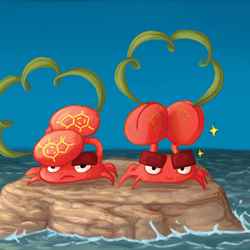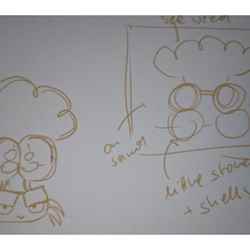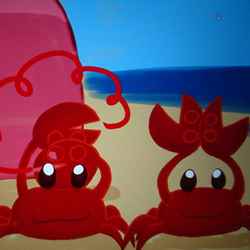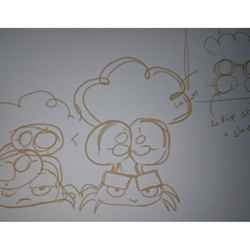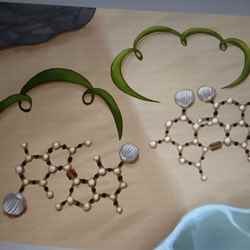Chiral crabs
Under the covers
Sander Wezenberg, and PhD students Thomas van Leeuwen and Kaja Sitkowska, from the University of Groningen in the Netherlands, spoke to us about their work in chirality and molecular motors, and the seaside scene on the cover of ChemComm that it inspired.
Chirality is a very important property in science and nature. It is a form of asymmetry, whereby you can have two objects that are identical in every way, except that they are mirror images of each other. Your hands are an example of a chiral object.
When chirality is applied to molecules, the two mirror-image forms of the molecule are referred to as isomers, and are often called the 'left-handed' and 'right-handed' isomer. It is very common for one isomer of a molecule to exist in nature, whilst the other isomer can only be obtained by synthesising it in a lab. "No-one knows where this preference for one chiral form in nature comes from", says Thomas. "It’s still a bit of a mystery in chemistry."
This can be a problem for chemists, as sometimes it is the non-naturally-occurring molecule that is the most useful in reactions, and for applications such as drug molecules. It is therefore very useful to be able to convert a molecule from one chiral form to the other.
Flipping chirality
Switchable chiral polymers – that is, long molecules that you can flip between left-handed and right-handed chiralities – have applications in, for example, sensing materials.
"We are working on a way to control the chirality of polymers using a small molecular motor as a trigger," says Thomas.
Sander explains: "We have a very unique molecule – a molecular motor – in which you can control the chirality using a sequence of light and thermally-activated steps. We have now found a way to transfer the chiral information from that molecule onto another molecule – the polymer – meaning that you can control the handedness of the polymer in a dynamic way."
Molecular motors are a hot topic in the group, which is led by Ben Feringa who won the Nobel Prize in 2016 for his work in this area, alongside fellow recipients Fraser Stoddart and Jean-Pierre Sauvage.
The molecular motor attaches itself to the polymer via non-covalent interactions and light is used as a stimulus to switch its chirality. Because of the way it is attached to the polymer, the polymer also switches.
From the art desk
Kaja is one of the PhD students in the group. She wasn’t involved in writing the paper but art is a hobby and she does most of the artwork for the group.
"I was thinking of summer when I designed the image", she says. "We have the sea, which represents the sea of other people’s work, then we have the stone which is our own little field, and on this stone we’re showing the others what we can do."
"The two crabs are displaying the molecular motors on their shells. The one on the right is being irradiated with sunlight, and it has different chirality to the one on the left. The seaweed represents the polymer."
The final image was drawn on a tablet, and below you can see some of Kaja’s preliminary sketches.
Read the article: Thomas van Leeuwen et al, Chem. Commun., 2017, DOI: 10.1039/C7CC03188B
This image appears on the front cover of Chemical Communications, 2017, Issue 48.
Press office
- Tel:
- +44 (0) 20 7440 3351
- Email:
- Send us an email
ChemComm
- Email:
- Send us an email

